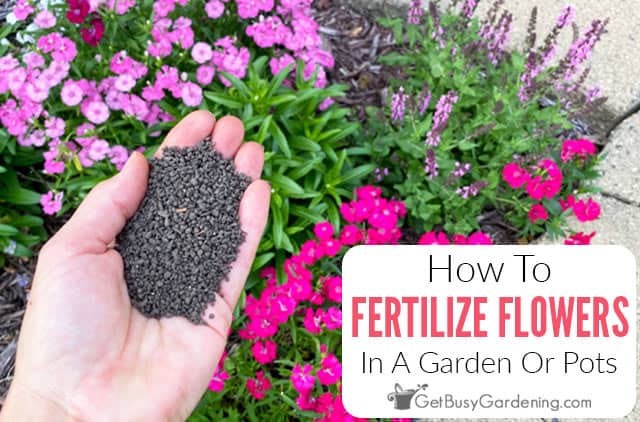So‚ you want a flower garden that’s bursting with color and life? That’s fantastic! But just like us‚ flowers need the right nutrients to thrive․ Think of fertilizer as the vitamins and minerals for your plants․ It’s not just about throwing some stuff on the ground; it’s about understanding what your flowers need and when they need it․ Let’s dive into the wonderful world of fertilizing your flower garden and unlock its full potential!
Why Fertilize Your Flower Garden?
Why bother fertilizing at all? Well‚ imagine trying to run a marathon on an empty stomach․ Not ideal‚ right? Flowers are the same․ Fertilizing replenishes essential nutrients in the soil that may be depleted‚ leading to:
- Stronger roots
- More vibrant blooms
- Increased resistance to pests and diseases
- Overall healthier and happier plants!
Without proper fertilization‚ your flowers might struggle to reach their full potential; They might be smaller‚ less colorful‚ and more susceptible to problems; So‚ let’s give them the boost they deserve!
Choosing the Right Fertilizer for Your Flower Garden
Not all fertilizers are created equal․ It’s like choosing the right food for your pet – you wouldn’t give a cat dog food‚ would you? Understanding the different types is key․ The numbers on the fertilizer bag (like 10-10-10 or 5-10-5) represent the percentage of Nitrogen (N)‚ Phosphorus (P)‚ and Potassium (K) – these are the big three nutrients your plants need․
Understanding NPK Ratios for Flower Garden Fertilization
Nitrogen promotes leafy growth‚ phosphorus encourages strong roots and blooms‚ and potassium helps with overall plant health and disease resistance․ For most flowering plants‚ a fertilizer with a slightly higher phosphorus number is beneficial․ Why? Because we want those beautiful blooms!
You’ll also find fertilizers labeled as:
- Granular: Slow-release and easy to apply․
- Liquid: Fast-acting and great for a quick boost․
- Organic: Made from natural sources and beneficial for soil health․
Consider organic options like compost‚ bone meal‚ or fish emulsion for a more sustainable approach․ They not only feed your plants but also improve the soil structure and encourage beneficial microbes․
Tip: Always read the fertilizer label carefully and follow the instructions․ Over-fertilizing can be just as harmful as under-fertilizing!
How to Fertilize Your Flower Garden: A Step-by-Step Guide
Okay‚ you’ve got your fertilizer․ Now what? Don’t worry‚ it’s not rocket science! Here’s a simple guide to get you started:
Timing is Key When Fertilizing Your Flower Garden
The best time to fertilize is usually in the spring‚ as new growth emerges․ You can also give your flowers a boost during their blooming season․ Avoid fertilizing during the hottest part of the summer or when plants are dormant․
Application Methods for Flower Garden Fertilizer
How you apply the fertilizer depends on the type you’re using․ For granular fertilizer‚ sprinkle it evenly around the base of the plant‚ avoiding direct contact with the stems․ For liquid fertilizer‚ dilute it according to the instructions and water your plants as usual․
Here’s a quick recap:
- Step 1: Choose the right fertilizer for your flowers․
- Step 2: Determine the appropriate timing for fertilization․
- Step 3: Apply the fertilizer according to the instructions․
- Step 4: Water your plants thoroughly after fertilizing․
Interesting Fact: Some flowers‚ like native wildflowers‚ don’t need as much fertilizer as others․ Research your specific plants to determine their needs!
Troubleshooting Common Fertilizing Problems in Your Flower Garden
Even with the best intentions‚ things can sometimes go wrong․ Here are a few common problems and how to fix them:
Over-Fertilizing: What to Watch Out For
Too much fertilizer can lead to burnt leaves‚ weak stems‚ and a build-up of salts in the soil․ If you suspect over-fertilizing‚ flush the soil with plenty of water to remove excess nutrients․
Under-Fertilizing: Signs Your Flowers Need a Boost
Signs of under-fertilizing include pale leaves‚ stunted growth‚ and a lack of blooms․ If you see these signs‚ give your flowers a gentle boost with a balanced fertilizer․
Soil Testing: Knowing What Your Flower Garden Needs
Consider getting your soil tested to determine its nutrient levels․ This will help you choose the right fertilizer and avoid over- or under-fertilizing․ You can usually find soil testing kits at your local garden center․
FAQ: Fertilizing Your Flower Garden
How often should I fertilize my flower garden?
It depends on the type of fertilizer and the needs of your plants․ Generally‚ fertilize in the spring and then again during the blooming season․
Can I use the same fertilizer for all my flowers?
While a balanced fertilizer can work for many flowers‚ some plants have specific needs․ Research your plants to determine the best fertilizer for them․
Is organic fertilizer better than synthetic fertilizer?
Organic fertilizers are generally better for soil health and the environment‚ but synthetic fertilizers can provide a quick boost of nutrients․ It’s a matter of personal preference and what works best for your garden․
What are the best organic fertilizers for flower gardens?
Compost‚ bone meal‚ fish emulsion‚ and seaweed extract are all excellent organic fertilizers for flower gardens․
Can I use coffee grounds as fertilizer?
Yes‚ coffee grounds can be a good source of nitrogen for your plants․ However‚ make sure to use them sparingly and mix them into the soil․
Fertilizing your flower garden doesn’t have to be a daunting task․ With a little knowledge and care‚ you can create a vibrant and thriving garden that you’ll be proud of․ Remember to observe your plants‚ adjust your approach as needed‚ and enjoy the process․ After all‚ gardening is a journey‚ not just a destination; So get out there‚ get your hands dirty‚ and watch your flower garden bloom!






